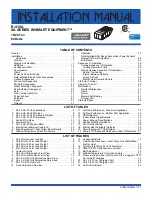
36
Contaminants in the gas lines may cause improper operation of the
gas control valve that may result in fire or explosion. Before attaching
the gas line be sure that all gas pipe is clean on the inside. To trap
any dirt or foreign material in the gas supply line, a sediment trap
must be incorporated in the piping. The sediment trap must be readily
accessible. Install in accordance with the Gas Piping section. See the
current edition of the
Natural Gas and Propane Installation Code (CSA B149.1).
Fire and Explosion Hazard
Leak test gas connections
before placing the water heater in
operation.
Disconnect gas piping at main
gas shutoff valve before leak
testing.
Install sediment trap in accordance
with NFPA 54 or CAN/CSA B149.1.
Use joint compound or Teflon tape
compatible with propane gas.
Use pipe joint compound or teflon tape marked as being resistant
to the action of petroleum [Propane (L.P.)] gases.
The water heater and its gas connection must be leak tested before
placing the water heater in operation.
The water heater and its individual Shut-off valve shall be
disconnected from the gas supply piping system during any pressure
testing of that system at test pressures in excess of 1/2 pound per
square inch (3.5 kPa). It shall be isolated from the gas supply piping
system by closing its individual manual Shut-off valve during any
pressure testing of the gas supply piping system at test pressures
equal to or less than 1/2 pound per square inch (3.5 kPa).
Fire and Explosion Hazard
Turn off gas lines during installation.
Contact a qualified installer or service
agency for installation and service.
Excessive gas pressure to gas valve can
cause serious injury or death.
Do not use water heater with any gas
other than the gas shown on the rating
label.
ELECTRICAL WIRING
All electrical work must be installed in accordance with the National
Electrical Code, ANSI/NFPA 70 or the Canadian Electrical Code,
CSA C22.1 and local requirements.
When installed, the water heater must be electrically grounded
in accordance with local codes or, in the absence of local codes,
with the National Electrical Code, ANSI/NFPA 70 or the Canadian
Electrical Code, CSA C22.1.
If any of the original wire as supplied with the water heater must
be replaced, it must be replaced with 105°C rated wiring or its
equivalent, except in the burner housing. In this case 200°C rated
wire must be used.
DEDICATED POWER WIRING AND BREAKERS
Dedicated power supply wires, neutral wires, ground wiring, and
dedicated circuit breakers often prevent electrical line noise and
are required when installing the water heater.
Note:
This water heater should not be connected to an electrical
supply with a Ground Fault Circuit Interrupter (GFCI) or Arc
Fault Circuit Interrupter (AFCI) with Integral GFCI protection
as defined in NFPA 70, CSA C22.1 and UL 943.
Read the requirements for the Power Supply on page 17 before
connecting power.
ENABLE / DISABLE CIRCUIT
The water heaters covered in this manual are equipped with an
enable/disable circuit for use with field-supplied external supervisory
controls, such as time clocks or Building Management Systems.
The enable/disable circuit may be used to disable heating operation
during periods when the building is unoccupied or there is no demand
for hot water.
To use the enable/disable circuit, it must first be activated by selecting
the “Use External Enable” from the UIM. Field-supplied wiring is then
installed between the water heater’s central control board (CCB)
and a set of “dry contacts” (no voltage or load) on the field supplied
external control.
NOTE: The water heater’s enable/disable circuit is a switching circuit
only: Do not apply external voltage or connect any load (IE: relay
coil) to this circuit. This will damage the CCB circuit board and is
not covered under the limited warranty. See the Residential Water
Heater Limited Warranty supplied with this water heater.
CONNECTING AN EXTERNAL SUPERVISORY CONTROL
The enable/disable circuit is accessed from the CCB’s J17 plug
inside the CCB enclosure; see Figure 1 (page 10) and Figure 1B
(page 11) to locate the CCB enclosure. Install field wiring to the
enable/disable circuit:
1.
Turn off power at the water heater’s enable/disable switch and
the breaker that supplies power to the water heater.
2.
Locate the CCB enclosure.
3.
Carefully remove the Temperature Probe connectors and CCB
enclosure cover.
4.
Locate pins 1 and 2 on the CCB J17 plug. See Figure 46 on
page 65.
5.
Connect the two field-supplied control wires to pins 1 and 2 on
the CCB J17 plug.
6.
Thread the control wires out of the CCB enclosure with the other
wiring and carefully replace the CCB enclosure cover. Ensure
all wiring is routed through the intended area provided for strain
relief. Ensure no wiring is being pinched.
7.
Reinstall the CCB enclosure cover and Temperature Probe
connectors.
8.
Route the control wires inside the junction box on the top of the
water heater; see Figure 1 (page 10) and Figure 1B (page 11)
to locate the junction box. Use an available knock-out to route
the wires inside the junction box.
9.
Install field-supplied control wiring and conduit as required by
national and local codes between the water heater’s junction box
and the external supervisory control. Connect the wiring from the
external control to the control wires inside the junction box using
wire nuts and electrical tape.
10.
Connect the control wiring to a set of dry contacts on the external
control. Follow the control manufacturer’s instructions for making
connections.
11.
Restore power to the water heater.
12.
From the water heaters UIM “Heater Information Screen” select
“Use External Enable” and change to “Yes”. See Figure 1 (page
10) and Figure 1B (page 11) to locate the UIM.
Содержание 300 Series
Страница 66: ...66 NOTES NOTES...
Страница 67: ...67 NOTES NOTES...
Страница 68: ...68 Copyright 2020 All rights reserved...
















































